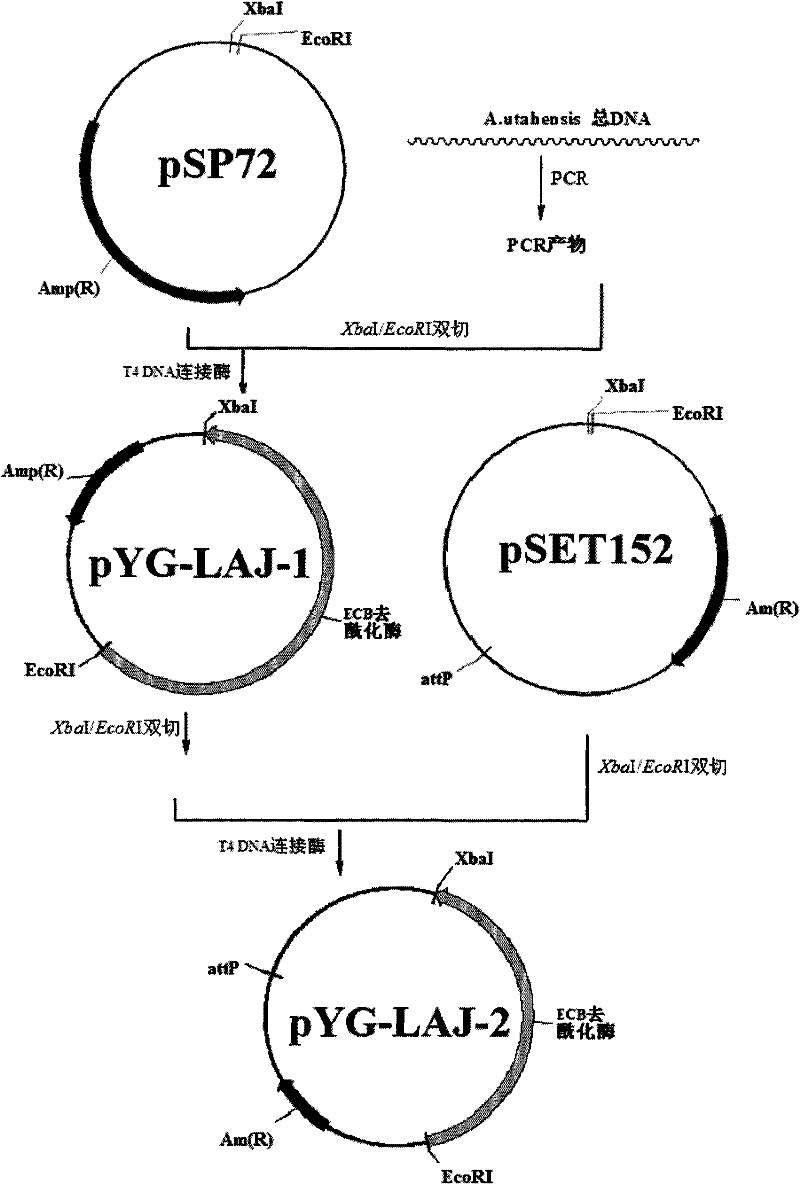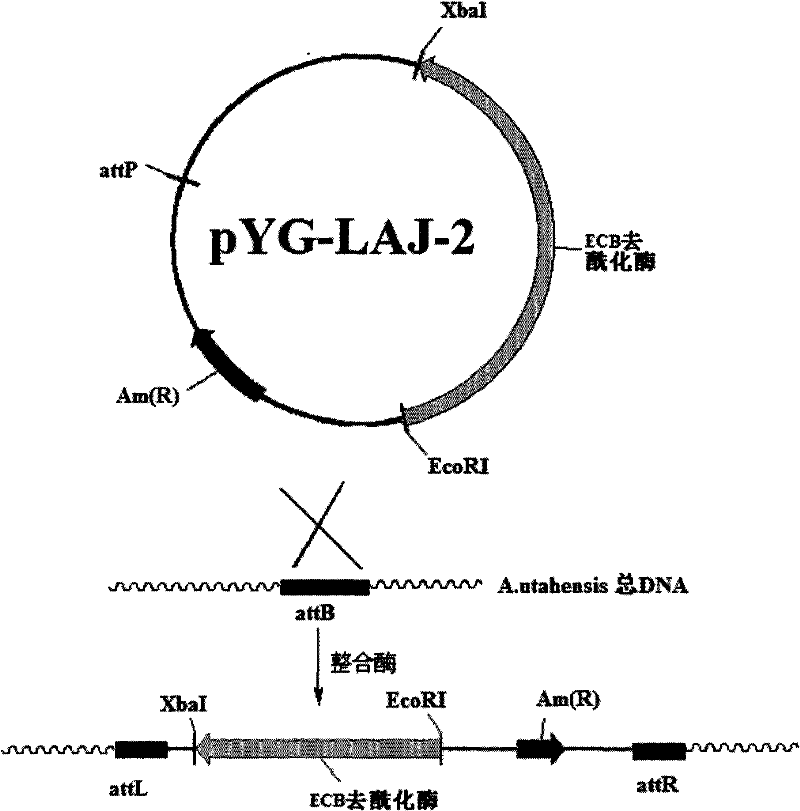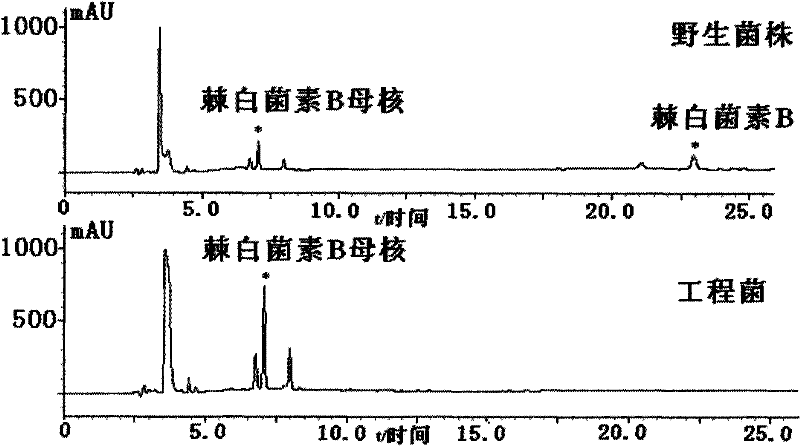Gene engineering bacterium for high efficiency conversion of echinocandin B and preparation method thereof
A technology for genetically engineered bacteria and echinocandin, which is applied to the field of genetically engineered bacteria for efficient transformation of echinocandin B and its preparation, can solve the problems of low yield of deacylase and low biotransformation efficiency of ECB, and achieves improved efficiency. Transformation efficiency, stable transformation efficiency, and the effect of increasing yield
- Summary
- Abstract
- Description
- Claims
- Application Information
AI Technical Summary
Problems solved by technology
Method used
Image
Examples
Embodiment 2
[0036] Example 2 Construction of specific site integration plasmid, conjugative transfer
[0037] The echinocandin B deacylase gene (EcoRI / XbaI) was ligated into the plasmid pSET152 (EcoRI / XbaI) purchased from Takara Company to obtain the recombinant plasmid pYG-LAJ-2. This recombinant plasmid is the integrated plasmid that multiplies the echinocandin B deacylase gene. Use this recombinant plasmid to transform Escherichia coli DH5α, pick the transformant and culture it in LB, extract the plasmid for enzyme digestion and PCR verification, and finally construct A site-specific integration plasmid pYG-LAJ-2 was formed. The schematic diagram of the above plasmid construction process is shown in figure 1 .
[0038] The slant cultured echinocandin B deacylase-producing bacteria——Actinoplanesutahensis NRRL 12052. Pick an appropriate amount of bacteria from the slope and culture it in 50ml TSB for about 72 hours to reach the logarithmic growth phase. Transfer 1% of the inoculum to ...
Embodiment 3
[0039] Example 3 Screening of Site-specific Recombinant Engineering Bacteria
[0040] The zygotes were picked and cultured in TSB containing abramycin (50 μg / ml), and then the bacterial solution was applied to a slant medium containing abramycin (50 μg / ml) (yeast extract 0.3%, malt leaching 0.3% peptone, 0.5% peptone, 1.0% glucose, agar 2.7, pH7.2), and cultured at 30°C. Because pSET152 contains phage The C31 integration site (attP) can specifically homologously integrate with the attB site in the actinomycete genome, and insert the Am resistance gene and echinocandin B deacylase gene carried by the plasmid pYG-LAJ-2 The zygote can stably express Am resistance gene and echinocandin B deacylase gene by reaching the attB site in the chromosome of Actinomyces Utahii and synchronously amplified with chromosome replication. The site-specific integration method, the schematic diagram is shown in figure 2 . The zygotes were picked and placed in a small test tube of 4ml TSB (con...
Embodiment 4
[0041] Example 4 Production of Echinocandin B Deacylase Transformation Echinocandin B Verification of Engineering Bacteria
[0042] Pick the mutant strain that can amplify the 4000bp fragment in Example 3 and cultivate it in slant medium (0.3% yeast extract, 0.3% malt extract, 0.5% peptone, 1.0% glucose, agar 2.7, pH7.2) at 30°C After culturing for one week, inoculate in the seed culture solution (2.0% sucrose, 2.0% oatmeal, 0.5% malt extract, 0.25% yeast, K 2 HPO 4 0.1%, KCl 0.05%, MgSO 4 ·7H 2 O 0.05%, FeSO 4 ·7H 2 O 0.0002%, pH natural), 30 ℃ for 4 days and then transferred to the fermentation medium (sucrose 2.0%, peanut powder 1.0%, K 2 HPO 4 0.12%, KH 2 PO 4 0.05%, MgSO 4 ·7H 2 O 0.025%, pH natural) (10% inoculum size). After 3 days of cultivation at 30°C and 250 r / m, the bottles were released. Get the fermented liquid and wash it several times with deionized water, after centrifugal precipitation (4000rpm, 20min), suspend with the fresh 0.1mol / L phosphate...
PUM
 Login to View More
Login to View More Abstract
Description
Claims
Application Information
 Login to View More
Login to View More - R&D
- Intellectual Property
- Life Sciences
- Materials
- Tech Scout
- Unparalleled Data Quality
- Higher Quality Content
- 60% Fewer Hallucinations
Browse by: Latest US Patents, China's latest patents, Technical Efficacy Thesaurus, Application Domain, Technology Topic, Popular Technical Reports.
© 2025 PatSnap. All rights reserved.Legal|Privacy policy|Modern Slavery Act Transparency Statement|Sitemap|About US| Contact US: help@patsnap.com



